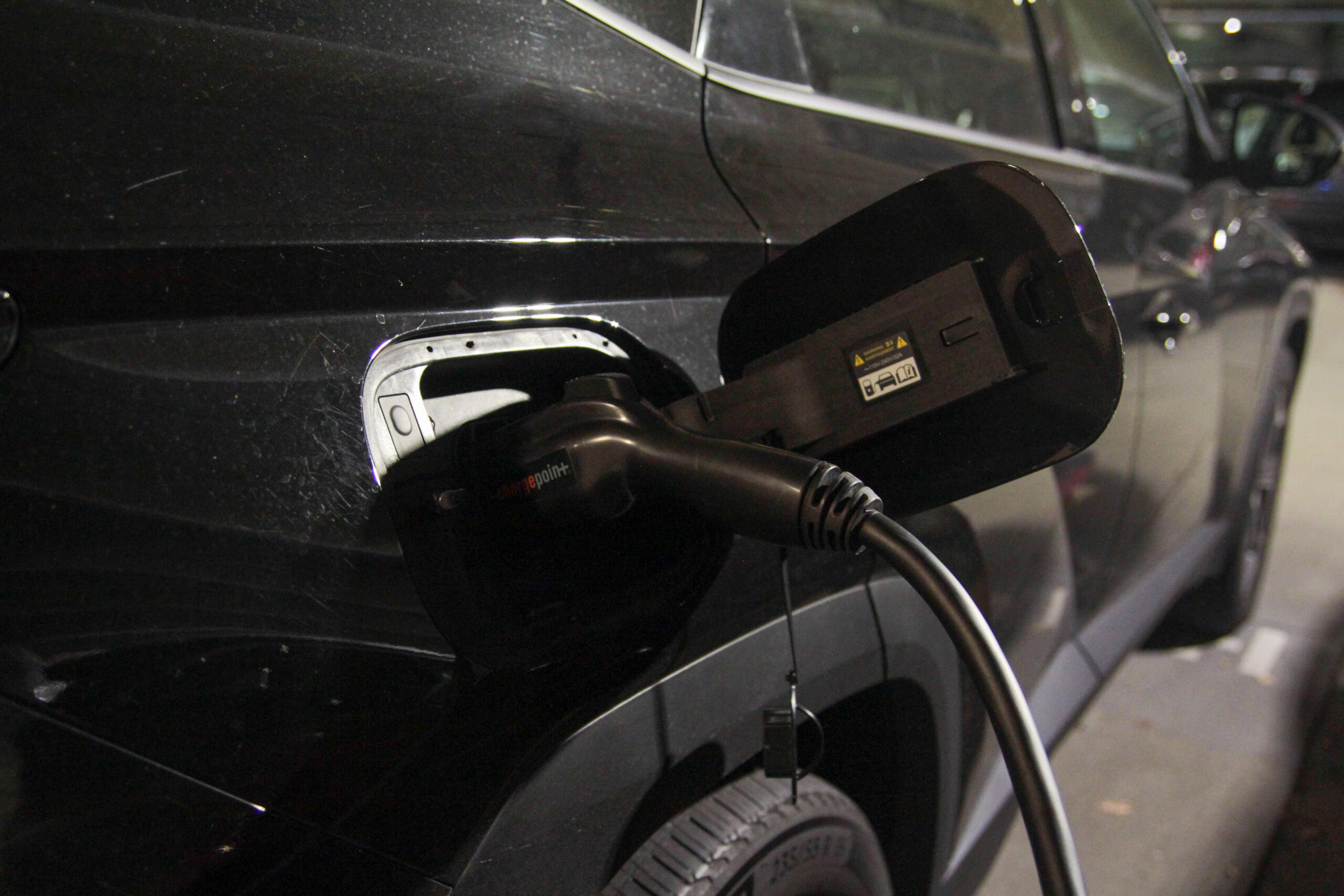State incentives to buy electric cars remain as federal credits end
Federal tax credits for electric vehicles expire on Oct. 1, but New Haven officials hope increased state rebates and new charging stations will continue to incentivize EV adoption.

Alex Hong, Contributing Photographer
Starting Wednesday, Americans who purchase a new or used electric vehicle, or EV, will no longer be eligible for a federal tax credit of up to $7,500.
But in Connecticut, those who purchase after the deadline can still enjoy statewide EV rebates of up to $4,000.
Republicans’ One Big Beautiful Bill Act defunded the federal EV tax credit program in July as a part of the Trump administration’s efforts to roll back long-standing federal green initiatives. However, federal investments in charging infrastructure passed under the Biden administration’s Inflation Reduction Act remain intact, leaving local officials optimistic that EV use will continue to rise.
“Cars and trucks contribute more than 40% of our climate pollution and the majority of ozone-forming emissions in the state. Expanding EV adoption is key to addressing air quality challenges that have impacted Connecticut residents for decades,” James Fowler, a spokesperson for the Connecticut Department of Energy and Environmental Protection, or DEEP, wrote to the News.
Which EV incentives remain?
After the federal tax credit expires on Oct. 1, Connecticut residents will still be eligible for rebates through the Connecticut Hydrogen and Electric Automobile Purchase Rebate — or CHEAPR — program.
Effective Oct. 1, any resident who purchases or leases an eligible battery EV from a licensed Connecticut dealership will receive $1,000 in rebates. The increase from the current $500 incentive was announced by the state last week and aims to help Connecticut residents buy EVs after federal tax credits expire, according to a DEEP press release.
The standard rebate for plug-in hybrids will remain at $500. Prequalified low- and moderate-income families can also obtain additional incentives for a total rebate of up to $4,000, according to DEEP.
Earlier in July, DEEP lowered standard incentives for both battery EVs and plug-in hybrids to conserve their budget in light of an “extreme jump” in EV rebate demand, officials said in a July 29 meeting explaining the CHEAPR cuts.
After Trump signed the tax-and-spending bill that cut federal tax credits on July 4, Connecticut consumers rushed to purchase EVs. The state’s average daily spending on CHEAPR incentives was 33 percent higher in the 30 days before July 29 than the 2025 year-to-date average, according to data shown at the meeting.
This far exceeded the target range of what the budget provided by the Connecticut General Assembly could support, DEEP official Paul Farrell said in the meeting.
While Barry Kresch, president of the EV Club of CT, expects EV sales to slow for a period of time after federal incentives expire, he is optimistic that sales will recover soon.
“I can’t tell you exactly when: it might be a year, it might be two years, but electric is the technology of the future, and all of the manufacturers know it,” Kresch said. “In fact, everybody knows it, except the president.”
As battery technology and charging infrastructure improves, EV prices will continue to drop, making EVs a more obvious choice for consumers in the near future, Kresch said.
Electric vehicles can offer a lower total cost of ownership, are far more efficient than comparable internal combustion engine vehicles and help reduce emissions in the transportation sector, DEEP spokesperson James Fowler wrote.
Connecticut has committed to bringing at least 125,000 EVs to the state by 2025. As of July 1, which predates the passage of Trump’s spending bill, there are only 67,656 registered EVs in the state, according to DEEP.
How convenient is an EV in New Haven?
Limited charging options are the largest barrier to expanding EV adoption among New Haven residents, Steve Winter ’11, executive director of New Haven’s Office of Climate and Sustainability, said.
Gaps in charging infrastructure are especially prohibitory in residential areas, where lack of access to a dedicated charging port at home or at an off-street location can dissuade residents who would otherwise purchase an EV, Winter said.
While the state’s “right-to-charge” law allows renters to install chargers in their residential space, renters may not choose to take up that cost if they’re not staying long-term, Winter added.
According to data from ChargeHub, there are 311 Level 2 and 3 charging ports in New Haven. But some charging stations in the city, such as the Tesla fast chargers at Long Wharf, may be restricted to a certain type of vehicle, Winter said.
While the New Haven Parking Authority offers EV chargers across 10 of its lots and garages in New Haven, these chargers might not be the most convenient if drivers aren’t planning to otherwise use those facilities, Winter said.
New charging stations
One of the city’s first priorities in EV adoption is to increase residential charging availability, Winter said.
Last November, Connecticut was awarded $14.6 million through the federal Charging and Fueling Infrastructure Grant Program to expand EV charging stations in seven communities, including New Haven.
New Haven’s portion of the grant will fund 24 new fast charging stations in two residential areas: 12 stations will be built next to the Wilbur Cross Athletic Complex in East Rock, and 12 will be installed on Chapel Street near Wooster Square, Winter said.
“Even if you’re not in one of those neighborhoods, they should be fairly easy to get to,” Winter said. “They’re both close to the highway and in the center of the city.”
As of early September, the state had already selected a vendor to provide support and implementation services for the grant and is working on drafting a contract, Winter said.
Those planning on driving their EV outside New Haven will also see nine more charging locations on major Connecticut highways, funded by the National Electric Vehicle Infrastructure Formula Program — or NEVI.
Meriden and Hartford will each have 4 new fast charging ports on Interstate 91 between New Haven and the Massachusetts border.
On Friday, the Connecticut Department of Transportation announced that the Federal Highway Administration approved Connecticut’s plan to utilize the NEVI funds for the new charging stations, allowing the state access to $52.5 million to build out charging infrastructure.
In February, the Trump administration had frozen NEVI funds indefinitely. The Department of Transportation decided to unfreeze all NEVI funds in August after a federal judge ordered the money to be distributed to more than a dozen states in June.
New Haven hopes to lead by example by purchasing and deploying electric vehicles in the community, Winter said.
“We hope to show that they reduce the city’s operating costs in terms of fuel and maintenance, and they provide cleaner air,” Winter said.
Last year, the city purchased more than 30 electric Chevrolet Bolts but experienced a lag in charging infrastructure to accommodate deploying all of them, Winter said. The city has since installed a bank of charging stations, including on State Street, on Chapel Street and at Board of Education facilities.
Now, the city electric fleet includes the Chevrolet Bolts, a refuse truck, a Parks Department truck that supports the charging of equipment like leaf blowers for ranger crews and two police vehicles, among others.
As of July 1, there are 1,264 registered EVs in New Haven, according to DEEP data.
Interested in getting more news about New Haven? Join our newsletter!







